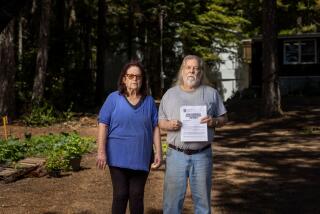Documents to Expect When Buying New Subdivision Home
Paper, paper everywhere: Welcome to home buying.
If you decide to buy a newly built home in a newly built development, you will face a stack of documents comparable to those involved in buying a resale home. But some are peculiar to newly built homes.
Eric Elder, vice president for sales and marketing with builder Kaufman & Broad, provides this guide through the paper work typical in the purchase of a newly built home.
Sales Package Checklist. A preview, roughly in order of appearance, of the forms that are standard for every transaction, plus special documents unique to each subdivision. You and the salesperson go over this together.
Cash Collection and Transmittal Record. The receipt for your deposit, which is separate from the sales agreement. (In resales, the two are combined.)
Features List. A disclosure of what is included in the home you buy, since models are professionally decorated and not everything in the model is in the production homes.
Receipt for Public Report. Acknowledgement that you have received and read the state Department of Real Estate report on the subdivision (described below). This form is required by the DRE, and must be kept by the builder for five years.
Department of Real Estate Final Subdivision Public Report. Also referred to as the âwhite reportâ or âwhite slip,â and the official follow-up to the shorter, preliminary âpink report.â This summarizes public facts about the subdivision: size, easements, geological elements, mineral rights.
It also reviews the operation of the homeowners association, if any, and explains what documents are available for you to examine (such as reports on soil conditions or landfills). The information in this DRE report is drawn from information provided by the builder.
Sales Agreement. A straightforward rundown of the terms and conditions of the sale: price, closing terms, construction terms, conditions for backing out; much of this is required by the DRE. Some builders combine this with escrow instructions.
Note the section on âliquidated damages,â which calls for your initials. This tells you how much of your money the builder can keep if you back out.
The sales agreement is comparable to the purchase contract on a resale home, except that the terms are less negotiable. It is your commitment to the home price and the legal terms of the sale.
Amendment to Purchase Agreement/Financing Agreement. For buyers who borrow through Kaufman & Broad. A different version is used if you get your loan from another lender. This is not a commitment; it just says what type of loan you are initially applying for, and that can change. (In resales, the sale and financing are separate processes; that is not always the case with newly built homes.)
Disclosure Regarding Real Estate Agency Relationships. In this context, this form notifies you that the salespeople have a fiduciary responsibility to the builder, not to the buyer. In other words, when you buy a new home, you have no agent working in your behalf.
Addendum to Sales Agreement/Repurchase Option. This is an âanti-speculator agreement,â Elder said. This gives the builder the right to buy back your house at the price you paid for it if you donât move in and stay there for a year after the close of escrow.
In a tract being built and sold in phases, as many developments are, each successive phase is offered at a higher price. When home prices were rising fast, speculators were buying first-phase homes, then putting them up for sale as soon as escrow closed--making a profit while selling at lower prices than the builderâs price on later-phase homes, Elder said.
This recently created agreement--which has been approved by the DRE but has not been tested in court--removes the potential for cashing in on quick appreciation.
Personal Identification for Title Insurance Company. Title companies require this for their reference when they are checking up on you. The escrow officer, title company or lender might also be the one to give you this straightforward form, which is also part of resales. It asks for Social Security numbers, past residences, past occupations and other identifying information.
Insurance Authorization. You can get fire insurance anywhere you like; lenders require it. To keep closing from being delayed, this authorizes the builder to get fire insurance for you if you neglect to do it yourself.
Addendum to Purchase Agreement/Insulation. A disclosure about the type of insulation the home has, strictly voluntary on the builderâs part. Builders may include these types of disclosures to head off any potential future litigation.
Disclosure Statement. A rehashing of some of what is in the âwhite report,â plus additional information provided âas a courtesyâ by the builder. Kaufman & Broadâs statement lists schools, emergency services, utilities, shopping facilities.
It explains the builderâs warranty, how to file warranty claims if you find something wrong that you believe is the builderâs responsibility and how disputes are to be settled.
This is also your acknowledgement of receiving copies of the CC&Rs;, budget, articles of incorporation, bylaws (described below) and final public report for the subdivision. You also sign a Product Disclosure, which says you understand that you donât get everything that is in the models. Special disclosures pertinent only to a particular subdivision might be attached. Elder describes this as a ready reference for buyers once they move in. You will need to pass all this information on to the next buyer.
Limited Warranty Agreement. A one-year warranty is standard in the building industry for cosmetic deficiencies; state law requires a 10-year structural warranty. This agreement includes manufacturersâ warranties on appliances. This also tells you how to make a claim, details what is not covered by warranty and explains how warranty disputes will be settled. Take the time to read this carefully.
Buyer Profile. The builderâs marketing department wants to know where advertising dollars are most efficiently spent. It asks your age, income, occupation and how you heard about the subdivision.
Proposition 65 Disclosure Statement. Accompanies a state-required compliance statement, which you keep; copies are also required to be posted in the sales office and on the construction site. This acknowledges that you got the builderâs statement detailing any possible exposure to chemicals known to cause cancer or birth defects.
These next six documents donât need your signature--they are for your information--but you will sign acknowledgements that you have received them.
Declaration of Covenants, Conditions and Restrictions, and Reservation of Easements. A description of the homeowners association (if any) and the governing of the subdivision. With detached homes, CC&Rs; are usually less important than where homes are attached to each other. This may be long and much of it written in legalese, but it is well worth reading carefully. It explains in detail how the association operates, what you may and may not do with your property and how the common areas are cared for. You must pass this on to future buyers.
Articles of Incorporation. The builder is required by DRE to incorporate a homeowners association before there are any actual homeowners. The initial board of directors are the builderâs employees; a property management company might be involved in a large subdivision. Bylaws and the articles spell out how and when the real homeowners are to take over. (If the subdivision has no common areas or maintenance needs, there may not be an association.) A preliminary budget for the association has to be given to you before escrow closes.
Budget Work Sheet. For the homeowners association. This preliminary estimate is where the number in the âwhite reportâ comes from. It includes fixed costs (taxes, insurance, local fees), operating costs (utilities, landscaping, maintenance, repairs), reserves, administrative costs and a contingency fund. The homeowners association must publish and distribute its budget annually.
Bylaws of the Homeowners Association. This is typically written by the builderâs counsel and handed to the new homeowners; the standard language is accepted by DRE. These are the rules governing the homeowners association.
Tract Description. A copy of the subdivision map that has been recorded with the county.
Supplementary Declaration of Covenants, Conditions and Restrictions, and Reservation of Easements. Covers any rules changed after the original statement is written. This can be changed by the homeowners association later.
More to Read
Sign up for Essential California
The most important California stories and recommendations in your inbox every morning.
You may occasionally receive promotional content from the Los Angeles Times.






